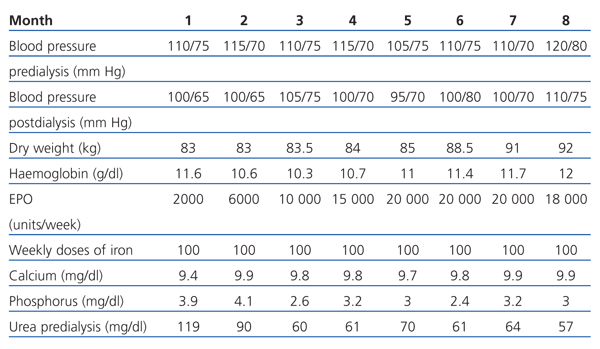To the Editor,
Frequency of pregnancies during haemodialysis is low (between 0.3% and 0.75% per year in women of child-bearing age).1 This fact is due to different hormonal factors which produce amenorrhoea.2-4
Maternal complications include: miscarriage, placenta abruptio, anaemia, infection, premature breakage of membranes, polyhydramnios, preterm labour, arterial hypertension, pre-eclampsia and eclampsia, haemorrhage, need for caesarean section, and maternal death. Foetal complications include: slow foetal growth, acute or chronic foetal distress, premature birth, newborn respiratory problems, increased stay in neonatal intensive care, and stillbirths or neonatal deaths.5,6
We present the case of a 31-year-old patient with chronic renal failure (CRF) secondary to interstitial and tubular kidney disease due to a neurogenic bladder. She started renal replacement therapy with haemodialysis 15 months before.
Her medical history included: lipomyelomeningocele, cauda equina syndrome; neurogenic bladder; 3 pregnancies (2 miscarriages and 1 live birth).
In April 2010, she reported amenorrhoea for one week, and ultrasound confirmed that she was 10 weeks pregnant. At this time, the patient had a creatinine clearance of 10ml/minute and residual diuresis of 2000ml/day (via self-catheterisation which has been performed since she was 5 years old due to her neurogenic bladder).
The following regimen was established:
Haemodialysis dosage was increased to six weekly sessions of 180 minutes, which resulted in: improved blood volume control (with no hypertensive or hypotensive events), less restriction on liquid intake solute fluctuation prevention, less episodes of low foetoplacental blood flow, reducing predialysis urea levels, and increasing protein intake.
We used a polysulfone dialyser with an ultrafiltration coefficient (KUf) of 82mL, and porous membrane thickness 40µm.
Qb was set at 300-350ml/minute and Qd at 500ml/minute.
The maximum ultrafiltration per hour was established at 400ml/hour to prevent hypotension. Weight adjustment was performed in accordance with the patient’s blood pressure and clinical profile.
Weekly analytical tests were performed.
Drug treatment was: erythropoietin, iron i.v., oral bicarbonate and folic acid. Paracalcitol was withdrawn given the lack of experience with this drug in pregnant patients.
We did not observe any alterations in blood sugar levels and the three O’Sullivan’s tests were normal.
The adjusted protein catabolism rate was 0.8 (same as before pregnancy) and the average standard Kt/V during the 9 months was 3.16. Weighted growth rate was 9kg.
Table 1 shows the remaining analytical parameters: blood pressure, dry weight, and erythropoietin dosage.
She did not have any fistula complications. She was not prescribed antihypertensive drugs at any moment.
Complications included: acute phlegmonous appendicitis (successfully repaired); haematuria with pathological urine sediments (treated with antibiotics). Haematuria disappeared and sediment normalised; and three urinary infection episodes (treated with antibiotics).
The patient was hospitalised at 36 weeks, having a forceps-assisted vaginal delivery. The baby weighed 2.9kg and Apgar score was 9/10.
The patient recovered satisfactorily. Residual diuresis and creatinine clearance results after 1 month were similar to pre-pregnancy results: 2000ml/day and 9ml/min, respectively. The other biochemical parameters were normal and she returned to her dialysis regimen of three sessions a week with good tolerance.
In 1980, the European Dialysis Transplant Association (EDTA) published a case study on 13 000 women of fertile age. There were 115 conceptions among them: 45 therapeutic abortions, 53 miscarriages, and of the remaining pregnancies, the birth rate was 23% 2
In 1996, Hou published another case study conducted in 206 North American dialysis units in 1990 and 1991. The sample included 1281 women between 18 and 44 years old. Almost 70% of the pregnancies before 1990 ended in miscarriage, while less than 40% after 1990 ended in abortion or miscarriage.2
There are very few cases described during recent years, and those which we have found have been from some centres’ isolated experience. Most report successful pregnancy rates, above 70%.7.8
In 2005, Haase et al9 published the first prospective study on 5 patients treated between 2000 and 2004 at the Charité University Hospital in Berlin with a 100% birth rate
Recently, Luders published a case study in the AMJ of all the pregnancies that occurred between 1988 and 2008 (it is the largest record to date) in women undergoing dialysis in the nephrology department of the San Paulo University Hospital, Brazil. Fifty-two pregnancies were studied, and 86.5% of them were successful.10
The survival rate of the babies born of mothers undergoing haemodialysis has improved, from 23% in 198011 to almost 90% during the last decade.9,10 However, foetal mortality is higher for women undergoing haemodialysis than the general population.5-9
To date, a systematic nephrological or gynaecological treatment for this type of patient has yet to reported in the medical literature.9
Various measures are mentioned in publications, such as: increase the erythropoietin dosage , increase dialysis time, use low ultrafiltration rates to improve blood volume control, avoid hypotension events, reduce liquid intake restrictions and maintain low predialysis urea levels.9,10,12,13
Pregnancy during dialysis continues to be rare and it occurs in various units. This makes it a difficult research point,14 but nevertheless these pregnancies should be included in a register, in the same way that other Societies and the EDTA have done.
Table 1. Clinical and laboratory variables and drug dose during pregnancy








